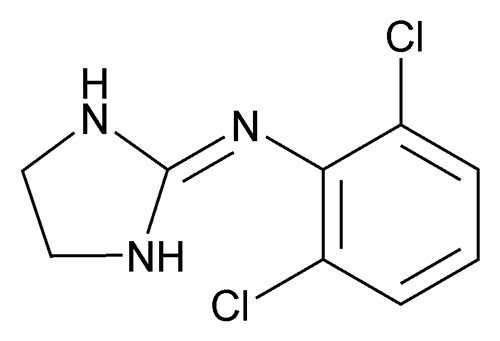Clonidine
Benzenamine, 2,6-dichloro-N-2-imidazolidinylidene-.
2-[(2,6-Dichlorophenyl)imino]imidazolidine
» Clonidine contains not less than 99.0 percent and not more than 101.0 percent of C9H9N3Cl2, calculated on the dried basis.
Packaging and storage—
Preserve in tight containers, and store at room temperature.
Identification—
B:
Ultraviolet Absorption  197U
197U —
—
Solution:
0.3 mg per mL.
Medium:
0.01 N hydrochloric acid.
Absorptivities for the maxima at 271 and 279 should be about 2.1 and 1.8, calculated on the dried basis.
Appearance of solution—
Color of solution—
Dissolve 1.0 g in 10.0 mL of methanol: the color of the solution is not more intense than 10 mL of a Standard solution containing 4.8 µg per mL of potassium chromate in water, when compared in matched color-comparison tubes (see Visual Comparison under Spectrophotometry and Light-Scattering  851
851 ).
).
Turbidity—
The test solution prepared as directed under Color of solution has no more turbidity than 10 mL of methanol, when compared in matched color-comparison tubes (see Visual Comparison under Spectrophotometry and Light-Scattering  851
851 ).
).
Loss on drying  731
731 —
Dry it under vacuum at 60
—
Dry it under vacuum at 60 to constant weight: it loses not more than 0.5% of its weight.
to constant weight: it loses not more than 0.5% of its weight.
Residue on ignition  281
281 —
Ignite at 500 ± 25
—
Ignite at 500 ± 25 to constant weight: not more than 0.1%.
to constant weight: not more than 0.1%.
Heavy metals, Method II  231
231 :
10 µg per g.
:
10 µg per g.
Chromatographic purity—
Solution A—
Dissolve 4 g of monobasic potassium phosphate in 1000 mL water. Adjust with 1 M phosphoric acid, prepared by diluting 115 g of phosphoric acid and diluting with water to 1000 mL, to a pH of 4.0.
Solution B—
Combine 750 mL of acetonitrile with 250 mL of Solution A.
Blank—
Solution A.
Mobile phase—
Use variable mixtures of Solution A and Solution B as directed for Chromatographic system (see System Suitability under Chromatography  621
621 ).
).
Acetylclonidine solution—
Dissolve about 1 mg of USP Clonidine Related Compound A RS in 1 mL of acetonitrile, and dilute with Solution A to 20 mL.
System suitability solution—
Combine an accurately weighed quantity of USP Clonidine RS and an appropriate volume of Acetylclonidine solution, and dissolve in and dilute with Solution A to obtain a solution containing about 0.86 mg per mL and 0.86 µg per mL, respectively.
Standard solution—
Dissolve an accurately weighed quantity of USP Clonidine RS in Solution A, and dilute quantitatively, and stepwise if necessary, with Solution A to obtain a solution having a known concentration of about 8.6 µg per mL.
Test solution—
Transfer about 43 mg of Clonidine, accurately weighed, to a 50-mL volumetric flask, dissolve in and dilute with Solution A to volume, and mix.
Chromatographic system (see Chromatography  621
621 )—
The liquid chromatograph is equipped with 210-nm detector and a 3.0-mm × 15-cm column that contains 5-µm packing L56. The column temperature is maintained at 40
)—
The liquid chromatograph is equipped with 210-nm detector and a 3.0-mm × 15-cm column that contains 5-µm packing L56. The column temperature is maintained at 40 . The flow rate is about 1.5 mL per minute. The chromatograph is programmed as follows.
. The flow rate is about 1.5 mL per minute. The chromatograph is programmed as follows.
Chromatograph the Blank and the System suitability solution, and record the peak responses as directed for Procedure: the resolution factor between clonidine and acetylclonidine is not less than 5; and the tailing factor for clonidine is less than 2.5. Chromatograph the Standard solution, and record the peak responses as directed for Procedure: the relative standard deviation for replicate injections of the Standard solution is not more than 5%.
| Time (minutes) |
Solution A
(%) |
Solution B
%) |
Elution |
| 0–15 | 90®30 | 10®70 | linear gradient |
| 15–15.1 | 30®90 | 70®10 | linear gradient |
| 15.1–20 | 90 | 10 | equilibration |
Procedure—
Separately inject equal volumes (about 5 µL) of the Standard solution and the Test solution into the chromatograph, record the chromatograms, and measure the peak responses for all peaks not observed in the Blank. Calculate the percentage of each impurity in the Clonidine taken by the formula:
5(C/W)(ri / rS)
in which C is the concentration, in µg per mL, of USP Clonidine RS in the Standard solution; W is the weight, in mg, of Clonidine used to prepare the Test solution; ri is the peak response for each impurity in the Test solution; and rS is the peak response of clonidine in the Standard solution: not more than 0.1% of any individual impurity is found; and not more than 0.2% of total impurities is found.
Assay—
Dissolve about 190 mg of Clonidine, accurately weighed, in about 100 mL of glacial acetic acid. Titrate with 0.1 N perchloric acid VS, determining the endpoint potentiometrically, using a silver–silver chloride glass combination electrode with liquid junction (see Titrimetry  541
541 ). Perform a blank determination, and make any necessary correction (see Titrimetry
). Perform a blank determination, and make any necessary correction (see Titrimetry  541
541 ). Each mL of 0.1 N perchloric acid is equivalent to 23.01 mg of C9H9N3Cl2.
). Each mL of 0.1 N perchloric acid is equivalent to 23.01 mg of C9H9N3Cl2.
Auxiliary Information—
Please check for your question in the FAQs before contacting USP.
Chromatographic Column—
| Topic/Question | Contact | Expert Committee |
| Monograph | Sujatha Ramakrishna, Ph.D.
Scientist 1-301-816-8349 |
(MDCV05) Monograph Development-Cardiovascular |
| Reference Standards | Lili Wang, Technical Services Scientist 1-301-816-8129 RSTech@usp.org |
USP32–NF27 Page 1988
Pharmacopeial Forum: Volume No. 29(1) Page 58
Chromatographic columns text is not derived from, and not part of, USP 32 or NF 27.

